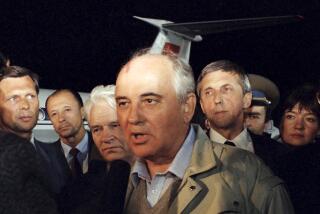Soviet rocket engineer shines after his death
MOSCOW — His work and even his name were once top Soviet secrets. It wasn’t until after his death that Sergei Korolyov became known to the world as the man who led the team that put the world’s first satellite into orbit and sent the first human into space.
Russia marked the 100th anniversary Friday of the birth of Korolyov, who suffered years of torture, starvation and hard labor in Josef Stalin’s gulag before becoming chief of the Soviet rocket program.
His daughter, Natalia, recalled how her father, who was forced to mine for gold in a labor camp amid freezing cold and hunger, loathed the precious metal for the rest of his days. “He kept repeating: I hate gold,” she said in an interview published in the daily Rossiiyskaya Gazeta.
Korolyov, an aeronautical engineer, was arrested in 1938 during Stalin’s Great Terror and sentenced to hard labor for anti-Soviet activities. Stalin’s henchmen broke his jaw during interrogations, he lost all his teeth, and after two years in the camp was on the verge of death with heart and other ailments.
He survived, thanks to aircraft designer Andrei Tupolev, who asked authorities to transfer Korolyov in 1940 from the labor camp to a design team working on new combat planes. The team worked behind bars, like many other Soviet design bureaus. Korolyov was freed in 1944.
When he saw his family for the first time, he talked for hours about his life in prison and then asked them to never question him about it again. “I want to forget that nightmare,” he said, according to his daughter.
She said his ordeal made him immune to fear of authorities. “Father simply wasn’t afraid of anything after that. He could boldly tell leaders that he categorically disagreed with something.”
After the Nazi defeat, Korolyov led a team of engineers who flew to Germany to gather information on V-2 rockets designed by Wernher von Braun, Korolyov’s future rival in the U.S.-Soviet space race. Korolyov’s team started by copying the German rocket but quickly developed its own designs.
After the first Soviet intercontinental ballistic missile designed by Korolyov was put in service in 1956, he offered to use one to launch a satellite into orbit. Korolyov’s deputy, Boris Chertok, recalled that the top brass opposed the idea as a distraction from the military program, but Soviet leader Nikita Khrushchev backed it.
“Korolyov was primarily a designer gifted with a rare insight, but he also was an excellent organizer,” Chertok told a news conference Thursday. “He realized that any big project requires a huge amount of organizational work.”
When Korolyov became aware of U.S. plans to launch the first American satellite in 1958, he shelved a complex Soviet project in favor of building a simple version quickly. On Oct. 4, 1957, Sputnik opened the Space Age.
Korolyov’s name was known only to Soviet leaders and a narrow circle of space workers, anonymity that sometimes made him sad. “We are like miners -- we work underground. No one sees or hears us,” his daughter recalled.
Rossiiyskaya Gazeta said Khrushchev twice rejected an offer from the Nobel Prize Committee to nominate the man who designed Sputnik and the spacecraft that carried the world’s first human, Yuri Gagarin, into space on April 12, 1961. “We can’t name one single person. It’s the entire people building the new technology,” Khrushchev was quoted as saying.
Korolyov’s daughter said her father dreamed about flying to space himself. After Gagarin’s flight, Korolyov told the family he wanted to be in his place: “I should have done it, but age is a problem and they wouldn’t let me do it anyway.”
She said Korolyov was superstitious -- opposing launches on Mondays and barring women from the launchpad. He carried two coins in his pocket and was distressed that he couldn’t find them on the day he was hospitalized in January 1966. He died of a heart attack during surgery just after turning 59.
It was his official obituary that first told the Soviet people -- and the rest of the world -- who Korolyov was.
Korolyov’s death dealt a crushing blow to the Soviet moon program, which collapsed in a series of booster explosions while the United States sent Neil Armstrong on his moon walk in 1969.
“Our successes would have been much greater if Korolyov [had] lived longer,” Chertok said.
More to Read
Sign up for Essential California
The most important California stories and recommendations in your inbox every morning.
You may occasionally receive promotional content from the Los Angeles Times.









